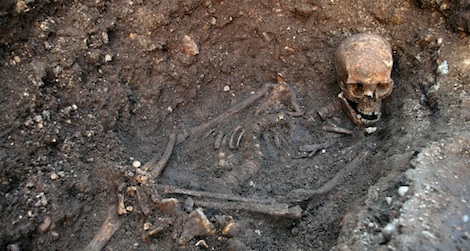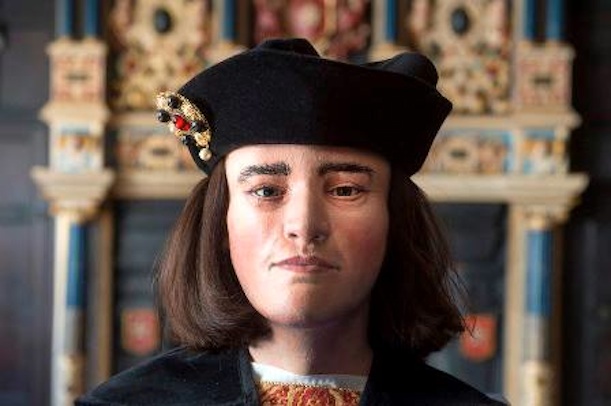Canadian carpenter Michael Ibsen (L), a descendant of England's King Richard III, the last of the Plantagenet dynasty, places a white rose on an oak coffin which he made containing the monarch's remains during a service held outside the University of Leicester in Leicester, central England, on March 22, 2015.
Some 530 years after he was killed in 1485, the last English monarch to die in battle will be laid to rest on Thursday in Leicester Cathedral, across the street from where his remains were found in 2012 under a municipal car park.
“God save King Richard!” Thousands line the streets to farewell the king found buried in a parking lot.
http://cnn.it/1Cfc1Wh
A cry rings out in the bright spring air as the simple oak coffin of Richard III is carried away from the tower block-filled campus of the University of Leicester for the final time.
CNN.COM|由 BRYONY JONES, CNN 上傳
一份新研究顯示,理查三世會喪命是因為少了一頂頭盔,而不是缺了一匹馬。

理查三世頭骨的新分析發現,他死前頭上被捅了好幾刀。攝影:University of Leicester via Corbis
編譯:魏靖儀
莎士比亞在他的作品《理查三世》中寫過:「馬!馬!我用我的王國交換一匹馬!」但一份新研究指出,英王理查三世(Richard III)之所以會死,不是因為缺一匹馬,而是缺了一頂頭盔。
針對理查三世的遺骸所進行的法醫研究顯示,這位命中帶劫的國王(英國最後一位戰死沙場的君王)於 1485 年死在波斯沃斯田的戰場上時,身上總共有 11 處創傷。其中有 9 處位於似乎沒受到任何保護的頭部,而根據英國 列斯特大學法醫科學家 Sarah Hainsworth 的說法,當中又有 2 處是「必死無疑」的。
這份研究利用全身的斷層掃描與微斷層造影技術,呈現出這位國王臨死前的慘烈時刻。當時他在一座沼澤裡跳下馬背,結果被至少三個、可能多達四個敵人圍攻,每個人都拿著戟、長劍和短刀。
「他受的傷顯示他遭受了連續攻擊,」Hainsworth 說。「頭骨上的傷口暗示他頭上沒戴頭盔 —– 至於是作戰時弄掉的還是最後他自己拿掉的,我們不得而知。他手掌和手臂上並沒有防禦性的傷口,暗示這些地方都還有鎧甲保護。」
關於那場戰爭的所有文獻一致記載,理查三世英勇作戰。法醫證據證實了這點。他確實很頑強。

最後一位戰死沙場的英國君王理查三世的骸骨2012年在一座停車場底下被發現。攝影:University of Leicester via Corbis
研究員注意到,他的顱骨上有幾處「削」傷,也就是有幾塊骨頭被某種帶有鋸齒的武器給削掉了,此外還有一處刺穿顱骨、直達大腦的穿刺傷。「那鐵定會痛,但他沒死,」Hainsworth 說。
另一處靠近顱骨右下方的穿刺傷刺進了他的腦部幾公分,最終是一定致命的。但一舉奪命的卻是更深、更狠的另外一擊,有人用戟(halberd)從他顱骨的左下方刺入大腦 —– 有 10 公分深。
「這應該就是最後一擊了。他幾乎是立刻失去意識,」Hainsworth 說。「呼吸和心跳會在一陣子之後停止。他不會是立刻斃命。中世紀的戰場沒有立刻死亡這種事。忘了那些電影情節吧 —– 在中世紀的戰場上,死亡一點也不乾脆、不浪漫。」
研究者也在這位殞落國王的骨盆一帶發現了另一處可能致命的重大創傷,但他們認為這是死後所為 —– 目的在於羞辱。

有人用劍刺穿了理查三世的骨盆。攝影:University of Leices via Corbis
「他若在活著的時候受了這個傷,定會流血而死,是在 20 分鐘內還是兩小時內我們很難說,但他穩死無疑,」Hainsworth 說。「但由於穿刺的角度古怪,他不太可能是作戰的時候被刺的,因為那個部位有鎧甲保護。」
根據記載,這場戰役結束後,理查三世的遺體被橫掛在馬背上,接著用拖車運走,由僧侶葬在附近一座教堂。
「如果有人想藉著最後這一刀來侮辱這位殞落的國王,遺體掛在馬背上的時候就是下手的最佳時機,因為姿勢剛剛好,」Hainsworth 說。「事實似乎就是這樣。」
理查三世雖是正統的英格蘭國王,也是約克家族的最後一位國王,但他的葬禮卻相當不風光,而且幾百年來墳墓位置都無人知曉 —– 直到 2012 年在列斯特(Leicester)的一座停車場底下被考古學家發現。
DNA 證據證實了這具骸骨確實屬於這位著名的國王。過去兩年來,他遺骨的法醫分析為這位中世紀英國國王的生活與時代背景提供了不少有趣的資訊。
May 23, 2013


New
archaeological analysis shows that King Richard’s remains were buried
in an awkward position, leaning against the wall of a grave that wasn’t
dug large enough. Image via University of Leicester
Last September, a team of archaeologists in the UK made a remarkable find: under a city council parking lot in Leicester, they found the remains of King Richard III. The king ruled England for just two years (from 1483 until 1485) before his violent war-time death.
In February, after comparing DNA taken from the skeleton to surviving descendants of the king and testing its age, the group officially confirmed the identity of the body. Since then, forensic analysis indicated that the king was killed by traumatic sword blows to the head—perhaps with enough force to drive his crown into his skull.
Now, the first academic paper to be published on the discovery
provides more unnerving details on the circumstances of Richard III’s
death. In a study to be published tomorrow in the journal Antiquity, the University of Leicester team writes
that the king’s body looks like it was buried in a hurry, crammed into a
hastily-prepared grave that was too small for him. Further, he was left
in a strange, slightly folded position, perhaps even with its hands
tied together.
Instead of a carefully-dug grave with straight walls, as was
customary during the era, Richard III’s has sloping walls, with a larger
size at the surface than at the bottom, as the team determined by
comparing the layered patterns in the dirt abutting the grave with the
unordered soil filling it and surrounding the king’s remains.
What’s more, the king’s head was left leaning against one corner of
the grave, indicating that a gravedigger stood in the hole to receive
his body and didn’t bother rearranging him at the center after putting
him down on the ground, and there’s no evidence that a coffin or even a
death shroud was used. Given the historical context of Richard III’s
death, none of this is a huge surprise, although the apparent lack
of care surrounding the burial of this king might exceed even what historians had previously expected.

A facial reconstruction of King Richard III based on his skull and other forensic details. Image via Leicester Arts & Museums
Richard III was killed at age 32 during the Battle of Bosworth Field, close to the end of the infamously violent War of the Roses period—a
30-plus year battle for power between supporters of competing branches
of the royal family for control of the throne. After he was defeated and
killed in battle by the forces of rival Henry Tudor (who would become King Henry VII),
the new king reportedly kept the burial location intentionally
secret—he feared it would otherwise become a rallying location for his
enemies—and knowledge of Richard III’s grave was lost over time.
Now we know that Richard III’s body was brought to the nearby city of
Leicester, passed along to Franciscan friars and buried at what was
then Grey Friars church “without any pomp or solemn funeral,” according
to the contemporary historian Polydore Vergil.
(Legend holds that his body was stripped naked, transported on the back
of a horse and mocked by passers-by during the entire journey.)
Eventually, the church was dismantled, and the site was paved over.
Apart from analyzing the unusual characteristics of the king’s grave,
the new paper also provides the first peer-reviewed forensic details
about his remains. As the archaeologists had previously mentioned in
public statements, the body matches the physical details of Richard III
as described in historical sources: a curved spine, due to childhood
scoliosis, and slim features. In addition to the fierce blows to his
head, there were a total of 10 wounds discovered on his body, including
stabs in his buttocks and back that the researchers believe were
probably made after he’d already been killed, because of their location and the fact that they couldn’t have been made while he was still wearing armor.
So, did Richard III die in violent humiliation? The new findings seem
to support this idea. At the very least, he was buried in a manner that
certainly didn’t befit a king. But now, a number of groups and
localities are suddenly interested in giving him a proper burial. The cities of Leicester and York are dueling over the right to
preserve his remains and attract the tourists that will flock to see
the king who was buried in a parking lot. We can only hope this new
battle doesn’t last for another 30 years.
The skeleton is 'beyond reasonable doubt' the remains of Richard III
A skeleton found beneath a Leicester car park has been confirmed as that of English king Richard III.
Experts from the University of Leicester said DNA from the bones matched that of descendants of the monarch's family.
Lead archaeologist Richard Buckley, from the University of Leicester, told a press conference to applause: "Beyond reasonable doubt it's Richard."
Mr Buckley said the bones had been subjected to "rigorous academic study" and had been carbon dated to a period from 1455-1540.
Dr Jo Appleby, an osteo-archaeologist from the university's School of Archaeology and Ancient History, revealed the bones were of a man in his late 20s or early 30s. Richard was 32 when he died.
His skeleton had suffered 10 injuries, including eight to the skull, at around the time of death. Two of the skull wounds were potentially fatal.
One was a "slice" removing a flap of bone, the other was caused by bladed weapon which went through and hit the opposite side of the skull - a depth of more than 10cm (4ins).
'Humiliation injuries'
Dr Appleby said: "Both of these injuries would have caused an almost instant loss of consciousness and death would have followed quickly afterwards.
Continue reading the main story
Who was Richard III?
- Richard was born at Fotheringhay Castle in Northamptonshire, where Mary Queen of Scots was later executed
- As Duke of Gloucester, Richard took a rampant white boar as his sign
- His coronation took place in Westminster Abbey, in a ceremony very similar to HM the Queen's
- Richard had one of the shortest reigns in English history - 26 months
- He was the last English king to die in battle, killed by the forces of the future Henry VII
"In the case of the larger wound, if the blade had penetrated 7cm into the brain, which we cannot determine from the bones, death would have been instantaneous."
Other wounds included slashes or stabs to the face and the side of the head. There was also evidence of "humiliation" injuries, including a pelvic wound likely to have been caused by an upward thrust of a weapon, through the buttock.
Richard III was portrayed as deformed by some Tudor historians and indeed the skeleton's spine is badly curved, a condition known as scoliosis.
However, there was no trace of a withered arm or other abnormalities described in the more extreme characterisations of the king.
Missing princes
Without the scoliosis, which experts believe developed during teenage years, he would have been about 5ft 8ins (1.7m) tall, but the curvature would have made him appear "considerably" shorter.
Dr Appleby said: "The analysis of the skeleton proved that it was an adult male but was an unusually slender, almost feminine, build for a man.
"Taken as a whole, the skeletal evidence provides a highly convincing case for identification as Richard III."
Richard was a royal prince until the death of his brother Edward IV in 1483. Appointed as protector of his nephew, Edward V, Richard instead assumed the reins of power.
Edward and his brother Richard, known as the Princes in the Tower, disappeared soon after. Rumours circulated they had been murdered on the orders of their uncle.
Challenged by Henry Tudor, Richard was killed at Bosworth in 1485 after only two years on the throne.
DNA trail
He was given a hurried burial beneath the church of Greyfriars in the centre of Leicester.
Mr Buckley said the grave was clumsily cut, with sloping sides and too short for the body, forcing the head forward.
Continue reading the main story
University of Leicester findings
• Wealth of evidence, including radiocarbon dating, radiological evidence, DNA and bone analysis and archaeological results, confirms identity of last Plantagenet king who died over 500 years ago
• DNA from skeleton matches two of Richard III's maternal line relatives. Leicester genealogist verifies living relatives of Richard III's family
• Individual likely to have been killed by one of two fatal injuries to the skull - one possibly from a sword and one possibly from a halberd
• Ten wounds discovered on skeleton - Richard III killed by trauma to the back of the head. Part of the skull sliced off
• Radiocarbon dating reveals individual had a high protein diet - including significant amounts of seafood - meaning he was likely to be of high status
• Radiocarbon dating reveals individual died in the second half of the 15th or in the early 16th Century - consistent with Richard's death in 1485
• Skeleton reveals severe scoliosis - onset believed to have occurred at the time of puberty
• Although about 5ft 8in tall (1.7m), the condition meant King Richard III would have stood significantly shorter and his right shoulder may have been higher than the left
• Feet were truncated at an unknown point in the past, but a significant time after the burial
"There was no evidence of a coffin or shroud which would have left the bones in a more compact position.
"Unusually, the arms are crossed and this could be an indication the body was buried with the wrists still tied," he added.
Greyfriars church was demolished during the Reformation in the 16th Century and over the following centuries its exact location was forgotten.
However, a team of enthusiasts and historians managed to trace the likely area - and, crucially, after painstaking genealogical research, they found a 17th-generation descendant of Richard's sister with whose DNA they could compare any remains.
Joy Ibsen, from Canada, died several years ago but her son, Michael, who now works in London, provided a sample.
The researchers were fortunate as, while the DNA they were looking for was in all Joy Ibsen's offspring, it is only handed down through the female line and her only daughter has no children. The line was about to stop.
Tomb plans
But the University of Leicester's experts had other problems.
Dr Turi King, project geneticist, said there had been concern DNA in the bones would be too degraded: "The question was could we get a sample of DNA to work with, and I am extremely pleased to tell you that we could."
She added: "There is a DNA match between the maternal DNA of the descendants of the family of Richard III and the skeletal remains we found at the Greyfriars dig.
"In short, the DNA evidence points to these being the remains of Richard III."
In August 2012, an excavation began in a city council car park - the only open space remaining in the likely area - which quickly identified buildings connected to the church.
 Richard's villainous reputation owes much to the way he was characterised by Shakespeare
Richard's villainous reputation owes much to the way he was characterised by Shakespeare
The bones were found in the first days of the dig and were eventually excavated under forensic conditions.
Details of the reburial ceremony have yet to be released, but Philippa Langley from the Richard III Society said plans for a tomb were well advanced.
She said of the discovery of Richard's skeleton: "I'm totally thrilled, I'm overwhelmed to be honest, it's been a long hard journey. I mean today as we stand it's been nearly four years.
"It's the culmination of a lot of hard work. I think, as someone said to me earlier, it's just the end of the beginning.
"We're going to completely reassess Richard III, we're going to completely look at all the sources again, and hopefully there's going to be a new beginning for Richard as well."



























